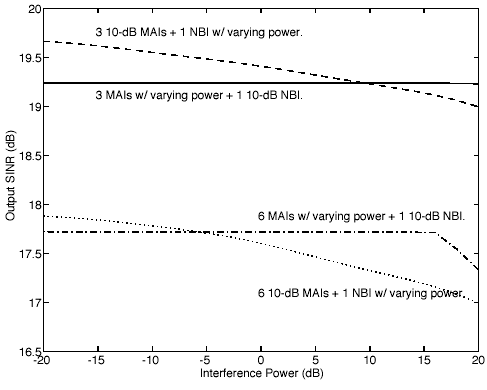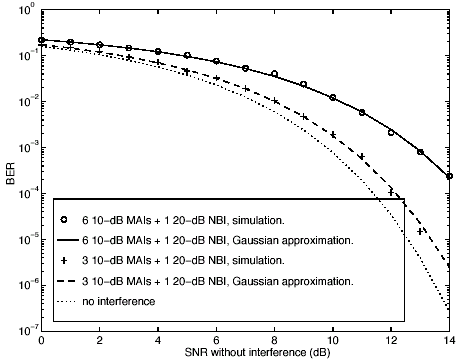7.6 NearFar Resistance to Both NBI and MAI by Linear MMSE Detector
7.6 Near“Far Resistance to Both NBI and MAI by Linear MMSE DetectorWe now consider the limiting behavior of the linear MMSE detector in the presence of NBI together with MAI, in which the energy of one or more of the interference signals (either MAI or NBI) can increase arbitrarily (i.e., the near“far situation). When the NBI is analog, the near“far resistance in the sense defined in [296, 297] is not easily determined, since in general the expression for the probability of error cannot be obtained. Another more intuitive view of a near“far resistant detector is that the output SINR is always greater than zero no matter how powerful the interference signal is [307]. In what follows we discuss the near“far resistance of the linear MMSE detector to both MAI and NBI in this sense. 7.6.1 Near“Far Resistance to NBIWe first consider the situation in which there is NBI but no MAI. Let the NBI signal i be an arbitrary discrete-time wide-sense stationary process, with autocorrelation matrix R i , which is nonnegative definite. Suppose that the spectral decomposition of R i is given by Equation 7.132 where l 1 ,..., l N and u 1 ,..., u N are the nonnegative eigenvalues and the corresponding orthogonal eigenvectors of R i . Since Equation 7.133 using (7.77) we obtain Equation 7.134 When the NBI signal power is increased, the nonzero l l 's increase proportionally. Therefore, it is seen from (7.134) that the near“far resistance to NBI is nonzero if and only if R i has at least one zero eigenvalue and the corresponding eigenvector is not orthogonal to s . On the other hand, if R i has full rank, the near“far resistance to NBI is zero. 7.6.2 Near“Far Resistance to Both NBI and MAINow suppose that the interference in the system includes ( K “1) independent synchronous MAIs in addition to the NBI. Let the signature vector for the k th MAI be s k and the power be P k . It is straightforward to generalize (7.77) to include the effect of MAI, and we obtain the output SINR of the MMSE detector as Equation 7.135 Equation (7.135) suggests that when we consider the output SINR for the linear MMSE detector, the NBI signal can be viewed as being equivalent to N independent synchronous virtual MAIs . The l th virtual MAI has signature vector u l and power l l . Suppose that r = rank( R i ) and l r +1 = ... = l N = 0. Then using the results from [307], the near“far resistance (to both MAI and NBI) is nonzero if and only if s is not contained in the subspace span{ s 1 ,..., s K ; u 1 ,..., u r }. Next we consider the effect of NBI on the near“far resistance to MAI, by fixing the power of the NBI and increasing the power of the MAIs. It is shown in [307] that the linear MMSE solution w is asymptotically orthogonal to the subspace spanned by s 1 ,..., s K : Equation 7.136 Such an asymptotic w can be found by solving the following constrained optimization problem: where Equation 7.137 It then follows from the method of Lagrange multipliers that Equation 7.138 where Therefore, from (7.136) and (7.138) it is easily seen that the near“far resistance to MAI is nonzero if and only if s Simulation ExamplesFigure 7.15 shows the output SINR of the linear MMSE detector in the presence of both MAI and NBI. The signal-to-noise ratio for the desired user in the absence of interference is fixed at 20 dB. The NBI is a second-order AR signal with both poles at 0.99. The MAIs are synchronous with the desired SS user , with random signature sequences and the same power. The processing gain is N = 31. Two cases are shown: three MAIs and six MAIs. For each case we vary the power of one type of interference (MAI or NBI) while keeping the power of the other fixed. Figure 7.15. Output SINR of a linear MMSE detector in the presence of both MAI and NBI. The noise power is held constant at s 2 = -20 dB relative to the SS signal after despreading. The NBI signal is a second-order AR signal with both poles at 0.99. The MAIs are synchronous with the SS user, with random signature sequences. The processing gain is N = 31. It is seen from Fig. 7.15 that the effects of the MAI and the NBI on the output SINR are different. The output SINR is insensitive to the power of the MAI while it is more sensitive to the power of NBI. To see this, we consider a simple example where the CDMA system consists of the desired SS user signal, one MAI and one NBI, in the absence of background noise. Then by (7.135) the output SINR of the MMSE detector in this case is given by Equation 7.139 where the second equality is obtained by using the matrix inversion lemma. Now because of the pseudorandomness of the signature vectors s and s 1 , Figure 7.16 is a plot of the probability of error of the MMSE detector, in the presence of strong MAI and NBI, in addition to ambient noise. The symbols o and + in this plot correspond to the data obtained from simulations, and the solid and dashed lines correspond to Gaussian approximations of the probability of error (i.e., BER). It was shown in [386] that in an environment of MAI and AWGN, the error probability for the MMSE detector can be well approximated by assuming that the output MAI plus noise is Gaussian. This plot seems to suggest that even in the presence of NBI, the output NBI plus MAI plus noise is still approximately Gaussian, as one would expect, since the NBI here is Gaussian. Figure 7.16. BER performance of a linear MMSE detector, in the presence of both MAI and NBI, in addition to ambient noise. The MAIs are synchronous with the SS user, with random signature sequence of length N = 31. The NBI signal is a second-order AR signal with both poles at 0.99. |
EAN: 2147483647
Pages: 91




 0.
0.  span
span  = s 2
= s 2 

